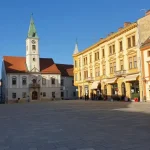If you were to ask the majority of people what they think of the Croatian economic outlook, the response would typically bleak. Is everything really so black, though? It would appear that certain experts, such as Boris Vujčić of the Croatian National Bank have some improved opinions on the Croatian economic outlook for 2020, and GDP growth seems to have replaced a potential slowdown.
As Novac/Marina Klepo writes on the 10th of December, 2019, although it has long been announced that the Croatian economy will experience a slowdown in the coming year, Governor Boris Vujčić is now seeing “something more optimistic” than the way things looked a couple of months ago.
According to CNB projections for next year, the Croatian economic outlook isn’t quite what we were all initially expecting, and it seems that the country’s GDP will grow by almost 3 percent, much as it did this year.
The risks to growth are, first and foremost, global and political risks, and as he said when presenting the edition of The Economist’s ”The World in 2020” (Svijet 2020), these risks include trade relations between the US, China and the EU and of course, the tired, old and quite frankly embarrassing story – the largely unpredictable yet undoubtedly extremely negative consequences of Brexit.
He believes that Croatia is currently more prepared for a potential recession than it was back in 2008, because it has succeeded in changing the structure of its economic growth. Before the crisis, he explained, growth was mainly based on imports and the accumulation of debt, and to date, that structure has changed, most notably when Croatia joined the EU, making the export part of the economy much more important, with both external and public debt falling significantly.
Prime Minister Andrej Plenković is no less optimistic about the Croatian economic outlook. The PM said that Croatia would be able to adapt to international circumstances, and that “with a government policy based on fiscal consolidation, structural reforms and attracting investment, it came to a level of resilience”. He also added that Croatia enjoyed faster growth from the EU average.
”I believe that we’re now even more capable and efficient in absorbing European Union funds, which will be important for investment and economic growth, so I expect a stable situation,” said Plenković, noting that the situation in Croatia is facilitated by the fact that this year, two out of three respected rating agencies returned Croatia’s rating to that of an investment level, which lowered the level of the cost of borrowing, both for the state and for economic entities and residents.
Despite the fact that the structure of the Croatian economy is different today than it was back in 2008, one thing has certainly failed (and quite miserably so) to change, and that is to reduce import dependence.
The CBS trade data just released indicate that this is unlikely to happen soon, either. When it comes to food production, which is the most significant part of Croatian industry and accounts for one fifth of exports, products worth 6.6 billion kuna were exported during the first nine months of this year, which is 445 million or 7.2 percent more than in the same period last year. At the same time, imports of food products increased by as much as 1.3 billion kuna or 11.5 percent, reaching 13 billion kuna.
The CBS also released the first data for ten months of 2019, showing that in that period, total merchandise exports amounted to 94.1 billion kuna, 5 percent more than in the same period last year, while imports reached 155.4 billion kuna and increased by 5.3 percent. Thus, Croatia’s foreign trade deficit increased by 3.3 billion kuna to 61.3 billion kuna, while the coverage of imports by exports decreased from 60.7 percent to 60.5 percent.
At the same time, the data for those same nine months shows an increase in exports at a rate of 6 percent, with imports increasing by 6.4 percent, suggesting that October brought with it a slowdown in trade. In terms of sectors, the strongest growth in exports in the aforementioned nine months was recorded by “other transport means”, of 40.2 percent, which indicates a stabilisation of the previously dire situation in Croatian shipbuilding. However, that sector’s imports have also increased sharply, by as much as 33.4 percent, so there may be some transit involved.
The export of tobacco products (37.9 percent), motor vehicles and trailers (29.1 percent), metals (17.6 percent), pharmaceuticals and rubber and plastics (12.9 percent) increased significantly. Exports of refined petroleum products fell the most, with a fall of 10.9 percent, while imports in this sector rose by as much as 35.9 percent. However, the largest increase was recorded in the import of tobacco products, by as much as 81.8 percent.
Those who sell goods in Germany, despite the announcement of a slowdown in demand, are still keeping up with the challenging pace: exports to the country increased by 5.9 percent in the first nine months of 2019. At the same time, exports to Italy, which still holds the number one position in terms of exports, grew by only 2.4 percent (imports increased by as much as 14.3 percent).
At slightly higher rates, exports to other EU countries are increasing: to Ireland, for example, exports more than doubled (to an impressive 106.5 percent), to Greece it increased by 83.3 percent, to Portugal by 28.9 percent, to Spain by 20.4 percent, and to Romania and Hungary by about 17 percent.
When it comes to Croatia’s neighbouring countries, exports to Slovenia fell by 1.9 percent, while exports from that country increased by 9 percent. At the same time, exports to Bosnia and Herzegovina grew at a rate of 15.3 percent, to Serbia 11.2 percent, and imports from these countries declined slightly.
Make sure to follow our dedicated lifestyle and business pages for much more on the Croatian economic outlook.







